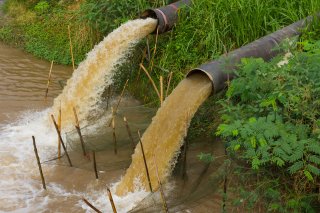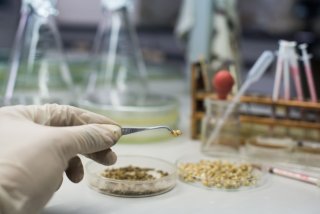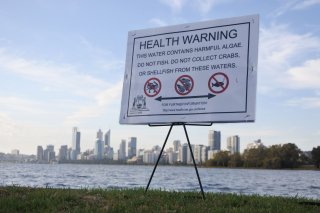How Do I Know if a Fish I Caught is Contaminated?
You can not tell if a fish or waterbody contains chemical pollutants by look or smell. The only way to tell if fish contain harmful levels of chemical pollutants is to have them tested in a laboratory. To find out if a waterbody contains harmful pollutants, look for warning signs posted along the water’s edge and follow their advice. Even if you do not see warning signs, contact your local or state health or environmental protection department for advice.
On this page:
- What kind of contaminants are in fish and shellfish?
- What is an Advisory?
- Federal and State Advice
- Testing for Contamination
What kind of contaminants are in fish and shellfish?

Fish are an important part of a healthy diet. They are a lean, low‐calorie source of protein. However, some fish may contain contaminants that could pose health risks if too much of these fish are eaten.
Contaminants found in fish, such as mercury, per- and polyfluoroalkyl substances (PFAS), polychlorinated biphenyls (PCBs), and dichloro-diphenyl-trichloroethane (DDT), can build up in your body over time and can cause serious, long-term health effects. States monitor for contaminated fish in their waters and issue fish consumption advisories. For current advisories, contact your local or state health or environmental protection department.
Learn more about some of the contaminants that can be measured in fish, and their effects on human health:
- Mercury - Nearly all fish and shellfish contain traces of mercury, no matter what body of water they come from. The risk from consuming mercury by eating fish and shellfish may include harm to an unborn baby or a young child's developing nervous system if the mercury levels are high enough.
- Per- and Polyfluoroalkyl Substances (PFAS)
- Polychlorinated Biphenyls (PCBs)
- Dichloro-diphenyl-trichloroethane (DDT)
- Harmful Algal Blooms (HABs) - Blooms with the potential to harm human health or aquatic ecosystems are referred to as Harmful Algal Blooms (HABs). HABs can produce toxins that present a risk to people and aquatic ecosystems, including commercial and industrial fishing, causing illness or even death when seafood contaminated with algal toxins are consumed.
What causes fish to contain chemical contamination?

Chemical pollutants in water come from many sources, including factories, sewage treatment plants, some chemical spills, or runoff from city streets and farm fields. Also, chemicals are carried long distances in the air and the atmospheric deposition of chemicals to land and water can lead to degraded water quality.
Fish may be exposed to chemicals in water and from the food they eat. Fish can accumulate some of the chemicals into their bodies which are often found in their skin, fat, internal organs and muscle tissue.
How can I find out if the waters that I fish in are polluted?
It’s almost impossible to tell if a water body is polluted simply by looking at it. However, there are ways to find out. First, look to see if warning signs are posted along the water’s edge. If there are signs, follow the advice printed on them. For advice, contact your local or state health or environmental protection department.
The How’s My Waterway tool provides an easily accessible picture of water quality at a community, state or national scale. Map-centric and mobile-friendly, How’s My Waterway works on all different screen sizes ranging from desktop computers and tablets to mobile phones.
What is an Advisory?
Fish advisories help people make informed decisions about where to fish or harvest shellfish when contaminant levels are unsafe. A consumption advisory is a recommendation to limit or avoid eating certain species of fish or shellfish caught from specific water bodies or types of water bodies (e.g., lakes, rivers or coastal waters) due to contamination. All 50 states and some U.S. territories and Tribes issue advisories to protect people from potential health risks of eating contaminated fish caught in local waters.
An advisory for a specific waterbody or type of waterbody may address more than one affected fish or shellfish species or contaminant. States, territories and Tribes provide advice on fish caught in waters in their jurisdiction. For current advisories, contact your local or state health or environmental protection department.
Advisories may be issued for the general public or for specific groups of people at risk, such as:
- People who eat a lot of fish
- Older people
- Pregnant females
- People who are nursing/nursing mothers
- Children
Federal and State Advice
Federal Advice
The EPA and FDA have issued advice regarding eating fish and shellfish. This advice is for females who might become pregnant, are pregnant, or are breastfeeding as well as parents and caregivers who are feeding children. It can help people make informed choices about the types of fish that are nutritious and safe to eat.
National Listing of Fish Advisories
From 1993 through 2011, the EPA collected fish advisory information from states, territories and Tribes. That information is available in the National Listing of Fish Advisories (NLFA). The NLFA includes fish advisories that were issued by states and territories from 1974 to 2011. To find historical fish advisories:
- Search Historical Advisories Where You Live (Basic Search)
- Search Historical Advisories (Advanced Technical Search)
- Search State Fish Tissue Data
State Safe Eating Guidelines
Some states issue both fish consumption advisories and safe eating guidelines. Safe eating guidelines let the public know when there are no limits on eating specific fish species. Like the fish consumption advisories, these guidelines are developed based on data from fish that have been tested for chemical contamination. Also, like fish consumption advisories, safe eating guidelines are issued for specific fish species from specific water bodies or types of water bodies by state and local agencies.
Testing for Contamination
Testing Shellfish for Contamination

Some state health departments monitor water quality and test shellfish harvested within their jurisdictions to assess toxin levels and the risk for contamination. Depending on the results of such testing, recreational and commercial shellfish harvesting may be prohibited locally during periods of water quality or shellfish contamination.
- For notices of illness outbreaks, shellfish closures, re-openings and recalls: Interstate Shellfish Sanitation Conference (ISSC)
- For current advisories, contact your local or state health or environmental protection department.
Testing for Harmful Algal Blooms

Certain environmental conditions in waterbodies, including warmer temperature and nutrient enrichment, can intensify algae growth causing algal blooms. Blooms with the potential to harm human health or aquatic ecosystems are referred to as Harmful Algal Blooms (HABs). HABs can produce toxins that present a risk to people and aquatic ecosystems, including commercial and industrial fishing, causing illness or even death when seafood contaminated with algal toxins are consumed. Therefore, consumption of mussels and clams collected during or immediately after blooms should be avoided.
